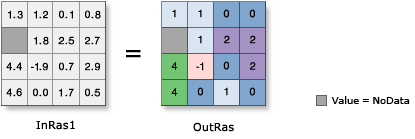| Label | Explanation | Data Type |
Input raster or constant value | The input raster to be converted to integer. To use a number as an input for this parameter, the cell size and extent must first be set in the environment. | Raster Layer; Constant |
Output raster | The output raster. The cell values are the input values converted to integers by truncation. | Raster Dataset |
Available with Spatial Analyst license.
Available with Image Analyst license.
Available with 3D Analyst license.
Summary
Converts each cell value of a raster to an integer by truncation.
Illustration

Usage
The input values can be either positive or negative.
If rounding is preferred to truncating, add a 0.5 input raster prior to performing the operation.
The maximum supported range of integer raster values is -2,147,483,648 (minimum size determined by -231) to 2,147,483,647 (maximum size determined by 231 – 1). If Int is used on a floating-point raster which has cells with values outside this range, those cells will be NoData in the output raster.
Storing categorical (discrete) data as an integer raster will use significantly less disk space than the same information stored as a floating-point raster. Whenever possible, it is recommended to convert floating-point rasters to integer with this tool.
If the input is a multiband raster, the output will be a multiband raster. The tool will perform the operation on each band in the input.
If the input is multidimensional raster data, all slices from all variables will be processed. The output will be a multidimensional raster in CRF format.
Parameters
arcpy.ddd.Int(in_raster_or_constant, out_raster)
| Name | Explanation | Data Type |
in_raster_or_constant | The input raster to be converted to integer. To use a number as an input for this parameter, the cell size and extent must first be set in the environment. | Raster Layer; Constant |
out_raster | The output raster. The cell values are the input values converted to integers by truncation. | Raster Dataset |
Code sample
This example converts the input values to integer by truncation.
import arcpy
from arcpy import env
env.workspace = "C:/data"
arcpy.Int_3d("gwhead", "C:/output/outint")This example converts the input values to integer by truncation.
# Name: Int_3d_Ex_02.py
# Description: Converts each cell value of a raster to an integer by truncation
# Requirements: 3D Analyst Extension
# Import system modules
import arcpy
from arcpy import env
# Set environment settings
env.workspace = "C:/data"
# Set local variables
inRaster = "gwhead"
# Execute Int
arcpy.ddd.Int(inRaster, "C:/output/outint")Environments
Licensing information
- Basic: Requires 3D Analyst or Spatial Analyst
- Standard: Requires 3D Analyst or Spatial Analyst
- Advanced: Requires 3D Analyst or Spatial Analyst